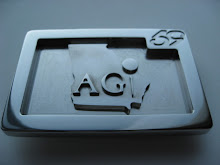
By: B.J. Hathaway, G.S.E.B., M.C.I.
Augusta Golf Instruction
Just like a green jacket at Augusta, a fine cigar and good round of golf are a perfect match for many golfers these days. Professional golfer Darren Clarke is a cigar connoisseur and it has been estimated that he spends £25,000 annually on cigars. Although most golfers don't have that kind of budget, finding the right cigar will make your round that much more enjoyable.
The golf course is one of the few places a good cigar can be enjoyed without worrying about where your smoke flies, and even if you're hitting it sideways a great cigar can mellow your golf nerves.
With golf there are certain fundamentals that apply to bring success and to really enjoy your cigar you need to know the basics. Recently I sat down with cigar expert José Ortega: Vice President of Sales for Reyes Family Cigars in Miami to get the inside information you need before heading to the first tee.
AGI: What is the best way to transport a cigar when playing golf?
José: I usually keep it in my mouth! But we have found also found an interesting tool that should do a fine job on the course called The Cigar T.
AGI: What are the keys to cutting and lighting a cigar properly?
José: You want to cut as little of the head as possible. A good cigar will draw with just a tad of the head cut. When you light your cigar, make sure it is even and take your time. You want to make sure the foot is evenly lit and blow into it to see.
AGI: Is there a best time to light up, as in before beginning a round of golf, or during?
José: Why wait, I like to light up right before I begin the round. I'm already happy to be on the course and away from the wife, let's make it a trifecta with a good cigar!
AGI: How do you judge a good cigar?
José: Cigars are purely subjective. What you may like, I may not. Just like wine and food, what you consider to be the best is what the best is.
AGI: Does ring size affect flavor?
José: Absolutely. Usually, the bigger the ring gauge, the cooler the smoke and the milder the cigar will be. The smaller ring gauges burn a little hotter and place more emphasis on the wrapper, which constitutes more of a percentage of the blend due to the proportions.
AGI: How about the wrapper?
José: Wrapper constitutes at least 70% of the flavor of a cigar, if not more in my opinion. The wrapper is the most important component of a cigar
AGI: Are there any etiquette rules that apply to cigar smoking?
José: My simple rules - never blow smoke in anyone's face and always be courteous to those around you if you light up a cigar in public. I understand that not everyone enjoys the odor of a cigar, and as a sign of respect I will ask those around me if it bothers them before I light up a cigar. That's of course if I am in an environment that is not an actual cigar shop.
AGI: How did you get into the cigar business?
José: My wife knew the Reyes family and found out they were looking for a National Sales Manager. I was working for a big company that sold conferences and was literally burned out. I was hired right on the spot on my first interview, back in 2003 and it's been smooth sailing ever since!
AGI: Tell us a little about the history of Reyes.
José: Rolando Reyes Sr. has been making cigars for 70 years! He is 84 right now and started in Cuba at the tender age of 14 or perhaps even younger. He moved to the United States, New Jersey to be exact, back in the 70's. From there, his business kept growing and he moved to the Dominican Republic in the 1980's. Towards the end of the decade, he decided to build a factory in Honduras, where he fell in love with the area when he visited. We have been manufacturing our cigars there in Danli, Honduras for the past 20 years.
AGI: What is your favorite cigar?
José: Well, asking me to choose a favorite cigar is like choosing a favorite child, but if you put a gun to my head, I'd have to say the Cuba Aliados Regordo is my personal favorite. It is a 6x60 cigar that delivers intense flavor and will give you an hour of undeniable smoking pleasure.
With 10 brands to choose from, Reyes certainly has a cigar that will suit any taste and make your time on the golf course more enjoyable. Special thanks to José Ortega and Frank Santos of Reyes for their valuable input and be sure to check out the entire line at http://www.purosindioscigars.com/.
For golf lessons in the Augusta area visit www.augustagolfinstruction.com
















